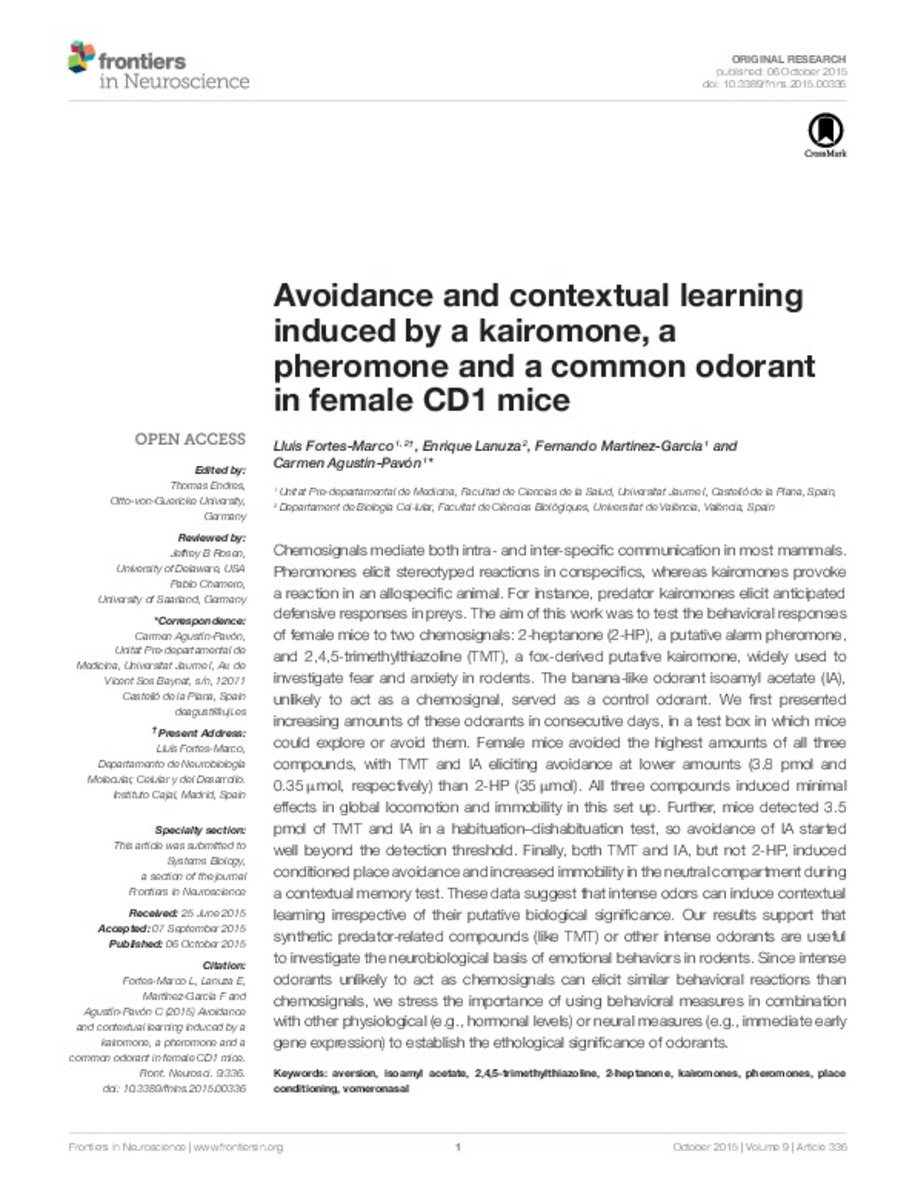Mostrar el registro sencillo del ítem
Avoidance and contextual learning induced by a kairomone, a pheromone and a common odorant in female CD1 mice
| dc.contributor.author | Fortes Marco, Lluís | |
| dc.contributor.author | Lanuza, Enrique | |
| dc.contributor.author | Martinez-Garcia, Fernando | |
| dc.contributor.author | Agustín-Pavón, Carmen | |
| dc.date.accessioned | 2016-04-27T14:35:04Z | |
| dc.date.available | 2016-04-27T14:35:04Z | |
| dc.date.issued | 2015 | |
| dc.identifier.citation | Fortes-Marco L, Lanuza E, Martínez-García F and Agustín-Pavón C (2015) Avoidance and contextual learning induced by a kairomone, a pheromone and a common odorant in female CD1 mice. Front. Neurosci. 9:336. doi: 10.3389/fnins.2015.00336 | ca_CA |
| dc.identifier.issn | 1662-453X | |
| dc.identifier.issn | 1662-4548 | |
| dc.identifier.uri | http://hdl.handle.net/10234/159006 | |
| dc.description.abstract | Chemosignals mediate both intra- and inter-specific communication in most mammals. Pheromones elicit stereotyped reactions in conspecifics, whereas kairomones provoke a reaction in an allospecific animal. For instance, predator kairomones elicit anticipated defensive responses in preys. The aim of this work was to test the behavioral responses of female mice to two chemosignals: 2-heptanone (2-HP), a putative alarm pheromone, and 2,4,5-trimethylthiazoline (TMT), a fox-derived putative kairomone, widely used to investigate fear and anxiety in rodents. The banana-like odorant isoamyl acetate (IA), unlikely to act as a chemosignal, served as a control odorant. We first presented increasing amounts of these odorants in consecutive days, in a test box in which mice could explore or avoid them. Female mice avoided the highest amounts of all three compounds, with TMT and IA eliciting avoidance at lower amounts (3.8 pmol and 0.35 μmol, respectively) than 2-HP (35 μmol). All three compounds induced minimal effects in global locomotion and immobility in this set up. Further, mice detected 3.5 pmol of TMT and IA in a habituation–dishabituation test, so avoidance of IA started well beyond the detection threshold. Finally, both TMT and IA, but not 2-HP, induced conditioned place avoidance and increased immobility in the neutral compartment during a contextual memory test. These data suggest that intense odors can induce contextual learning irrespective of their putative biological significance. Our results support that synthetic predator-related compounds (like TMT) or other intense odorants are useful to investigate the neurobiological basis of emotional behaviors in rodents. Since intense odorants unlikely to act as chemosignals can elicit similar behavioral reactions than chemosignals, we stress the importance of using behavioral measures in combination with other physiological (e.g., hormonal levels) or neural measures (e.g., immediate early gene expression) to establish the ethological significance of odorants. | ca_CA |
| dc.format.extent | 13 p. | ca_CA |
| dc.format.mimetype | application/pdf | ca_CA |
| dc.language.iso | eng | ca_CA |
| dc.publisher | Frontiers Media | ca_CA |
| dc.relation.isPartOf | Front. Neurosci., 06 October 2015 | ca_CA |
| dc.rights | This Document is Protected by copyright and was first published by Frontiers. All rights reserved. it is reproduced with permission. Copyright © 2015 Fortes-Marco, Lanuza, Martínez-García and Agustín-Pavón. This is an open-access article distributed under the terms of the Creative Commons Attribution License (CC BY). The use, distribution or reproduction in other forums is permitted, provided the original author(s) or licensor are credited and that the original publication in this journal is cited, in accordance with accepted academic practice. No use, distribution or reproduction is permitted which does not comply with these terms. | ca_CA |
| dc.rights | Attribution 4.0 Spain | * |
| dc.rights.uri | http://creativecommons.org/licenses/by-sa/4.0/ | * |
| dc.subject | Aversion | ca_CA |
| dc.subject | Isoamyl acetate | ca_CA |
| dc.subject | 2,4,5-trimethylthiazoline | ca_CA |
| dc.subject | 2-heptanone | ca_CA |
| dc.subject | Kairomones | ca_CA |
| dc.subject | Pheromones | ca_CA |
| dc.subject | Place conditioning | ca_CA |
| dc.subject | Vomeronasal | ca_CA |
| dc.title | Avoidance and contextual learning induced by a kairomone, a pheromone and a common odorant in female CD1 mice | ca_CA |
| dc.type | info:eu-repo/semantics/article | ca_CA |
| dc.identifier.doi | http://dx.doi.org/10.3389/fnins.2015.00336 | |
| dc.rights.accessRights | info:eu-repo/semantics/openAccess | ca_CA |
| dc.relation.publisherVersion | http://journal.frontiersin.org/article/10.3389/fnins.2015.00336/full | ca_CA |
| dc.type.version | info:eu-repo/semantics/publishedVersion |
Ficheros en el ítem
Este ítem aparece en la(s) siguiente(s) colección(ones)
-
MED_Articles [673]
Articles de publicacions periòdiques
Excepto si se señala otra cosa, la licencia del ítem se describe como: This Document is Protected by copyright and was first published by Frontiers. All rights reserved. it is reproduced with permission.
Copyright © 2015 Fortes-Marco, Lanuza, Martínez-García and Agustín-Pavón. This is an open-access article distributed under the terms of the Creative Commons Attribution License (CC BY). The use, distribution or reproduction in other forums is permitted, provided the original author(s) or licensor are credited and that the original publication in this journal is cited, in accordance with accepted academic practice. No use, distribution or reproduction is permitted which does not comply with these terms.








